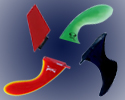Fin Setups
Quads Offer Speed and More
 When someone researches surfboard design for a new board a small debate often arises during the quest for information. Quad fin vs. tri-fin thruster? Quad fin vs. twin fin? Quad fin vs. other quad fins? This debate is one of many struggles we face during the eternal quest for better equipment. More than ever before the performance characteristics of a quad fin deserve strong consideration. The recent interest in quad fin setups is justified due to the increased speed, strong hold in hollow waves and high maneuverability.
When someone researches surfboard design for a new board a small debate often arises during the quest for information. Quad fin vs. tri-fin thruster? Quad fin vs. twin fin? Quad fin vs. other quad fins? This debate is one of many struggles we face during the eternal quest for better equipment. More than ever before the performance characteristics of a quad fin deserve strong consideration. The recent interest in quad fin setups is justified due to the increased speed, strong hold in hollow waves and high maneuverability.
How Do Quad Fins Ride?
Speed
While fins produce drag when surfing in a straight line, they also help hold and change direction. Shapers will shape a board so it channels water through the back of the board. Water hitting a thruster’s tail fin will slow you down. Water rushing out the back of the tail unobstructed does not cause this deceleration. Where this really provides an advantage is in smaller surf. A surfer on a thruster must generate his own speed whereas a quad will naturally scream down the line.
Large Surf
Many of the world’s top big wave surfers ride quad fins when braving treacherous breaks like Mavericks and Jaws. The reason for the superior hold in larger surf is the two fins near the rail working together. There is no doubting the appeal of a faster board with more hold when trying to outrun a bomb.
Response
You may also want to ask yourself why you wouldn't want a couple fins further up the board if it meant an easier time going rail to rail. More fins under your foot will help any surfer direct his board with more control and with less response time. They also hold a higher line in steeper waves and generate more drive through a turn.
Loosenness
The reason a quad fin set up produces a looser, skatier board is because it lacks the back fin, which also acts as a tracking fin on thrusters. You may notice your quad is very responsive, but you may not always feel that you have complete control in the wave's face. It must be noted that a quad suits a different surfing style than the thruster. It will take some time in the water to adjust your bottom turns, performing moves at a higher speed, and the loose feel. The four fins provide more fin surface area, offering plenty of drive. Still, you hear some surfers say they slide out on bottom turns when first getting accustomed to a quad. Upside: More fin, more hold, more efficient rail turns. Downside: tough to achieve release when attacking the lip.
The real question you need to ask yourself is this: how quickly you can I react to the speed a quad offers? If you're not careful you will be screaming down the line and only getting one turn in before you're at the end of the road. Better nail that big carve back to the sweet spot. Bottom line, a quad is a possible option if you want to really carve the fat off a two foot wave, if you are a power surfer looking for more drive through turns, you are just an average surfer who wants to go faster down the line, or you charge big waves and want to live to tell the grandkids.














7 Comments